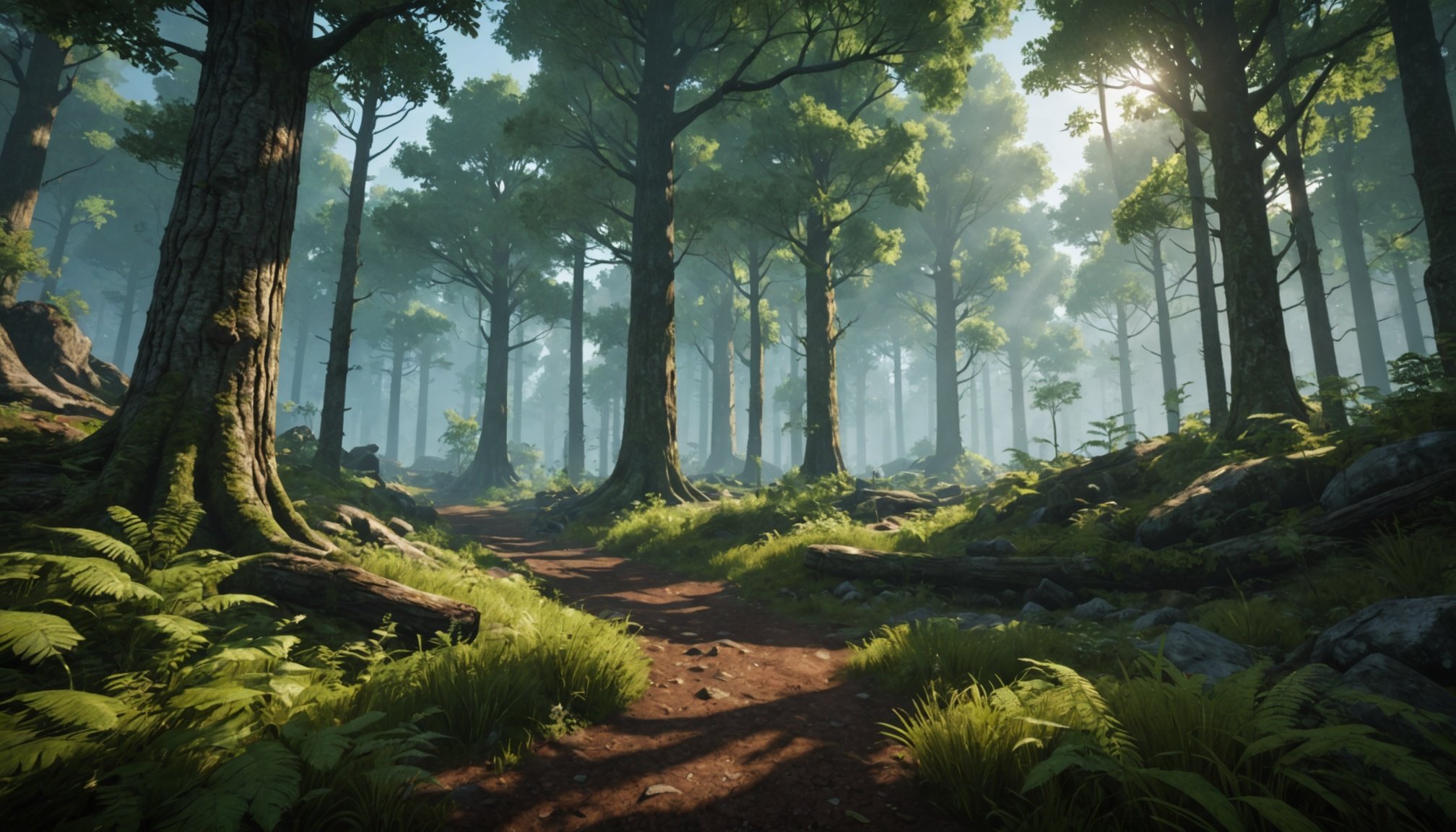Techniques for Designing Lifelike Foliage
In the realm of game environment design, the art of crafting convincing and realistic foliage creation is an essential skill. One of the foundational foliage design techniques is the use of high-quality textures. These textures are derived from reference photos, which provide a basis for creating lifelike details that mimic natural elements. Through careful study of natural environments, designers can ensure that their virtual foliage mirrors real-world counterparts.
Texture isn’t the only element to consider. The shape of foliage plays a crucial role in achieving realism. By observing different plants in various climates, designers can replicate the intricate structures of leaves and branches, adding depth and authenticity to virtual landscapes.
Topic to read : Exploring boundless realms: how procedural generation transforms survival games with limitless landscapes
Moreover, the role of lighting and shadows cannot be underestimated. Realistic foliage becomes even more immersive when light sources interact dynamically with the shapes and textures, casting natural shadows that change with environmental conditions. This interplay of light adds a layer of realism that standard static models cannot achieve.
Incorporating these strategies results in environments that are not only visually appealing but also resonant with authenticity, drawing players more deeply into the game’s world. Innovators in this field continually refine their methods, pushing the boundaries of what virtual nature can represent.
Also read : Mastering multiplayer dynamics: navigating key hurdles in developing next-gen vr experiences
Recommended Software and Tools
In the vibrant world of game design software, selecting the right tools for foliage creation is crucial. Let’s dive into some top-notch software popular within the industry. Blender is a well-loved choice among many game developers for its comprehensive foliage modeling capabilities and open-source flexibility. Its user-friendly interface allows designers to craft intricate models with precision, making it an essential part of any game development toolkit. Alternatively, ZBrush offers robust modeling features specifically suited for creating detailed vegetation textures, thanks to its intuitive sculpting environment that breathes life into virtual terrain.
When it comes to texture painting, Substance Painter sets itself apart as a staple for realistic foliage rendering. It allows for intricate detailing and realistic texture application, enhancing visual fidelity. The combination of these tools provides a comprehensive suite for designers aiming to achieve stunning environmental aesthetics.
Furthermore, accessing high-quality asset libraries can drastically enhance your project’s outcomes. Many libraries offer pre-modeled foliage assets, saving both time and effort. This enables developers to focus on other creative processes. Investing in such game development resources is invaluable, ensuring your game world flourishes with realism and beauty.
Visual Examples and Tutorials
Navigating foliage visual examples and game design tutorials can vastly enhance your creative prowess. When approaching these elements, it’s crucial to grasp the comprehensive techniques involved.
Step-by-step Tutorial for Creating Tree Models
Creating tree models begins with introducing basic shapes and progressively detailing them with branch and leaf patterns. Start by using a 3D software, then refine your design by carving out fine details. Adjust each layer with varying opacities to achieve a realistic look. Free resources provide numerous references to streamline your process.
Techniques for Texturing Grass and Underbrush
Texturing demands attention to detail and natural variation. Focus on employing different shade gradients for grass and underbrush to mimic natural growth patterns. Layer multiple textures to simulate depth and weathering, enhancing realism.
Using Particle Systems for Dynamic Foliage Effects
Particle systems are pivotal in designing dynamic foliage effects. Harnessing them can simulate effects like sway and wind interaction, adding realism. Tailor these systems to respond to in-game stimuli, creating an engaging environment.
These practices underscore the numerous possibilities at your fingertips, enabling you to leverage tree models, textures, and particle dynamics in your projects. The goal is not only to inform but to inspire the next steps in your creative journey.
Role of Foliage in Game Immersion
In gaming, creating a believable environment significantly enhances game immersion techniques. Foliage, with its subtle rustling and varied textures, plays a crucial role in this. When foliage is designed to mimic real-life vegetation, it enriches the player’s experience, making virtual worlds feel authentic. This environmental storytelling allows players to imagine themselves in lush forests or arid deserts, each plant contributing to the narrative without a single word spoken.
Foliage also transforms exploration mechanics by influencing how players navigate their surroundings. Dense thickets might obscure hidden paths or treasures, encouraging exploration and fostering a sense of discovery. Conversely, sparse vegetation might provide open, expansive views, promoting strategic planning in combat scenarios.
Many successful games, such as “The Witcher 3” and “Red Dead Redemption 2,” masterfully utilise foliage to create rich, immersive worlds. In “The Witcher 3,” the swaying grass and rustling leaves dynamically react to the player’s presence, enhancing realism. Meanwhile, “Red Dead Redemption 2” uses a variety of plants to delineate its diverse environments, from lush forests to barren plains. These games show how thoughtful integration of foliage can amplify the player’s sense of immersion and interaction with the virtual world.
Artistic Styles and Optimization Techniques
In the realm of gaming, artistic foliage design plays a pivotal role, lending visual authenticity to virtual landscapes. Game developers often explore a variety of artistic styles to bring these environments to life, ranging from hyper-realistic to stylized aesthetics. Each style offers a unique experience, captivating players and enhancing immersion.
However, creating stunning foliage isn’t just about aesthetics. Optimization strategies are crucial for ensuring that beautifully designed foliage doesn’t bog down game performance. Techniques include using lower-polygon models for foliage in the distance, reducing texture resolution, and employing level-of-detail (LOD) systems. These strategies maintain a balance between visual fidelity and efficiency, crucial for smooth gameplay.
Achieving this balance is particularly challenging across different platforms. While high-end PCs can handle detailed foliage with ease, consoles and mobile devices may require more intricate optimization techniques. Developers often have to adjust levels of detail or implement dynamic rendering to tailor the experience to each platform’s capabilities.
By incorporating both artistic foliage design and robust optimization strategies, developers can create breathtaking virtual environments that run seamlessly, enriching the player’s gaming experience without sacrificing performance.











